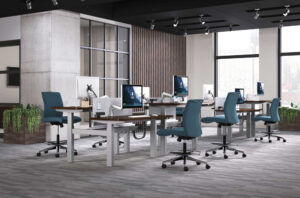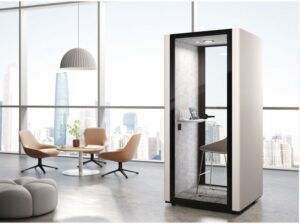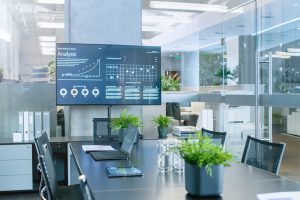19 Dec Evaluating Six Employee Office Space Expectations
Office space expectations from the experience of Mac MacCardle, MyOffice’s Director of Design & Furniture/Director of Sales. With over 40 years of office space outfitting, his insights are invaluable for his numerous current and former clients.
In the ever-evolving corporate landscape, the concept of office space has transcended its traditional boundaries. It is no longer merely a physical location where employees congregate to carry out their duties. Instead, it has become a reflection of a company’s values, culture, and commitment to its workforce. As an experienced professional, I firmly believe that meeting employee office space expectations is paramount to fostering a productive, motivated, and engaged workforce.

The Importance of Meeting Employee Expectations
The office environment plays a pivotal role in shaping employee experiences, attitudes, and overall well-being. When employees feel that their needs and preferences are taken into consideration, they are more likely to feel valued, respected, and motivated to contribute their best efforts. Conversely, an office space that fails to meet their expectations can lead to dissatisfaction, disengagement, and ultimately, a decline in productivity and retention rates.
By prioritizing employee office space expectations, organizations can cultivate a positive and supportive work environment. An environment that attracts and retains top talent. This, in turn, can lead to increased job satisfaction, improved morale, and a stronger sense of loyalty and commitment to the company’s mission and goals.
Expectation 1 – Comfort and Ergonomics in The Office Space
One of the primary expectations that employees have regarding their office space is comfort and ergonomics. Spending long hours at a desk can take a toll on physical well-being, leading to musculoskeletal issues, eye strain, and fatigue. To address this, it is crucial to provide ergonomically designed workspaces. The best solutions promote proper posture and minimize strain.
 Adjustable desks, supportive chairs, and appropriate lighting are essential elements that contribute to a comfortable and ergonomic work environment. Additionally, incorporating standing desks or treadmill desks can encourage movement and alleviate the negative effects of prolonged sitting.
Adjustable desks, supportive chairs, and appropriate lighting are essential elements that contribute to a comfortable and ergonomic work environment. Additionally, incorporating standing desks or treadmill desks can encourage movement and alleviate the negative effects of prolonged sitting.
By prioritizing comfort and ergonomics, organizations can enhance employee experience in the office. Increased productivity, reduced absenteeism due to work-related injuries, and a healthier and more engaged workforce are proven benefits.
Expectation 2 – Privacy and Personal Space Considerations
In an age where open-plan offices have become the norm, employees often crave a sense of privacy and personal space. While collaborative spaces are essential, it is equally important to provide personal space carveouts. Quiet zones or designated areas where individuals can focus on tasks that require concentration or engage in confidential discussions are a must.
 Private offices, soundproofed meeting rooms, or dedicated quiet areas can offer employees the privacy they need. Additionally, incorporating elements such as noise-canceling headphones or sound-masking systems can help mitigate auditory distractions and promote a more focused work environment.
Private offices, soundproofed meeting rooms, or dedicated quiet areas can offer employees the privacy they need. Additionally, incorporating elements such as noise-canceling headphones or sound-masking systems can help mitigate auditory distractions and promote a more focused work environment.
By respecting employees’ need for privacy and personal space, organizations can foster an atmosphere of trust, respect, and productivity. This focus can ultimately contribute to a positive work-life balance and overall job satisfaction.
Expectation 3 – The Role of Technology In Meeting Office Space Expectations
In today’s digital age, technology plays a pivotal role in shaping employee office space expectations. From cutting-edge collaboration tools to seamless connectivity, employees expect their office space to be equipped with the latest technological advancements. They are seeking technology to support their work and enhance their productivity.
 Incorporating modern audio-visual systems, high-speed internet connections, and user-friendly software and applications can streamline communication, facilitate remote collaboration, and enhance overall efficiency. Additionally, providing employees with access to the latest hardware and devices can empower them to work more effectively and efficiently.
Incorporating modern audio-visual systems, high-speed internet connections, and user-friendly software and applications can streamline communication, facilitate remote collaboration, and enhance overall efficiency. Additionally, providing employees with access to the latest hardware and devices can empower them to work more effectively and efficiently.
By embracing technology and integrating it seamlessly into the office space, organizations can not only meet employee expectations. Your business will also position itself as forward-thinking and innovative. This makes attracting top talent and fostering a culture of continuous improvement much easier to achieve.
Expectation 4 – Collaboration And Flexibility in The Office Space
In today’s dynamic work environment, collaboration and flexibility are essential components of employee office space expectations. Employees seek spaces that promote teamwork, foster creativity, and encourage cross-functional collaboration.
 Incorporating open-plan layouts, huddle rooms, and collaborative spaces is important for spontaneous interactions, brainstorming sessions, and knowledge-sharing among team members. Additionally, offering flexible workspaces, such as hotdesking or hot-desking areas, can cater to the needs of mobile workers. These choices foster a sense of adaptability and agility within the organization.
Incorporating open-plan layouts, huddle rooms, and collaborative spaces is important for spontaneous interactions, brainstorming sessions, and knowledge-sharing among team members. Additionally, offering flexible workspaces, such as hotdesking or hot-desking areas, can cater to the needs of mobile workers. These choices foster a sense of adaptability and agility within the organization.
Expectation 5 – Office Amenities and Perks That Meet Employee Expectations
Addressing the core requirements of the physical workspace is undoubtedly crucial. However, employees also have expectations regarding the amenities and perks offered within the office environment. These can range from on-site fitness centers and wellness programs to gourmet cafeterias and recreational spaces.
Providing amenities such as bike storage facilities, shower rooms, or dedicated nursing rooms can cater to the diverse needs of employees and promote a healthier work-life balance. Additionally, offering perks like free snacks, coffee bars, or game rooms can create a more enjoyable and engaging work environment. Fostering a sense of community and promoting overall well-being is the core evaluation no matter what amenities are provided. Addressing these core features will enhance your ability to attract and retain top talent in a competitive job market.
Expectation 6 – Creating A Positive Office Culture
While the physical aspects of the office space are crucial, it is equally important to cultivate a positive and inclusive office culture. This involves fostering an environment of respect, diversity, and open communication.
Encouraging employee feedback and actively involving them in the decision-making process regarding office space design and layout can foster a sense of ownership and buy-in. Additionally, promoting initiatives that celebrate diversity, foster inclusivity, and encourage work-life balance can contribute to a positive and supportive office culture.
By prioritizing a positive office culture, organizations can create a sense of belonging and purpose among employees. Increased job satisfaction, loyalty, and overall productivity are important byproducts of this focus.
The Overall Impact of Office Space on Employee Productivity and Satisfaction
The relationship between office space and employee productivity and satisfaction is undeniable. A well-designed and thoughtfully curated office environment will have a profound impact on employee engagement, motivation, and overall performance.
Numerous studies have shown that employees who work in environments that meet their expectations are more likely to experience higher levels of job satisfaction, reduced stress, and increased creativity. This, in turn, can translate into improved productivity, better decision-making, and enhanced overall organizational performance.
Conclusion: The Future of Employee Office Space Expectations
As the workplace landscape continues to evolve, so will employee office space expectations. Embracing emerging trends, such as sustainable and eco-friendly office designs, biophilic elements, and cutting-edge technologies, will become increasingly important in meeting the evolving needs and preferences of the modern workforce.
 Organizations that remain agile, adaptable, and responsive to employee feedback will be best positioned against competitors. You will be better able to:
Organizations that remain agile, adaptable, and responsive to employee feedback will be best positioned against competitors. You will be better able to:
- Attract and retain top talent.
- Foster a culture of innovation.
- Maintain a competitive edge in an ever-changing business environment.
By prioritizing employee office space expectations, organizations can create a win-win situation. Employees thrive in an environment that supports their well-being and productivity. Organizations benefit from a motivated, engaged, and high-performing workforce.
At MyOffice, we understand the importance of creating an office environment that meets the diverse needs and expectations of our clients. We invite you to explore our comprehensive office space solutions, designed to foster productivity, collaboration, and overall well-being. Contact our team of office furniture experts today to learn how we can help you navigate these concerns.
MyOffice has over 20 years of experience in supporting client’s implementing office solutions. We understand the needs of the modern office environment. Optimizing your workspace through furniture selection and layout is a core competency of ours. We are here to help!

